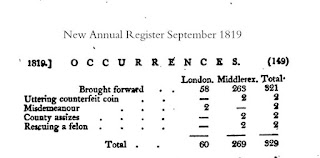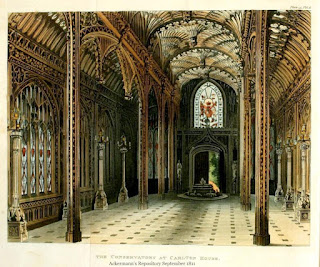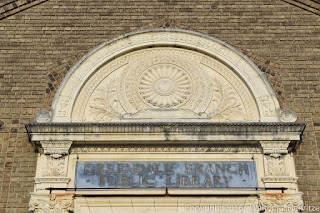Isabella reporting,
While Loretta and I are self-proclaimed history nerds, we're not historians. Instead we're fiction writers whose books are inspired by history (and, of course, we share more of that history as bloggers, too.) I'm always interested to see how other people are inspired by history. Fashion designers in particular often dip into the past to make something new from something old. The late Alexander McQueen was a master of this, and thanks to a
recent exhibition at the RISDMuseum, I have another favorite: designer Todd Oldham.
I visited
All of Everything: Todd Oldham Fashion last month, shortly before it closed, and I'm so glad I did. The show focused on the couture fashion created by Oldham in the 1990s. For those of us who lived through it, the decade was an exuberant era for fashion, with bright colors, short skirts, and lots of sparkle, but Oldham took that exuberance to an entirely different level.
The exhibition featured 65 full ensembles, displayed in a runway-style setting that made it possible to see the clothes from all angles. And such amazing clothes! True, these aren't everyday clothes, but they are true works of art, featuring exquisite embroidery, luxurious textiles, and embellishment that included crystals and metallic threads. According to the exhibition notes, Oldham sought out master craftspeople from around the world to bring his designs to life, taking a special interest in encouraging and preserving artisan industries, and it showed in the exquisite details.
But what I enjoyed the best was seeing how he "quoted" and incorporated elements from the past into his clothes. The dress,
above left, (as always, please click on the images to enlarge them) from 1992 was inspired by Byzantine jewelry Oldham had seen at the Metropolitan Museum of Art. According to the placard, he replicated that jewelry "by embellishing four-ply silk crepe with 18-karat gold bullion, faceted glass, and semiprecious stones. This was the most expensive dress [Oldham] ever made, and it now lives permanently in the Met, which makes sense."
More gold bullion turned up unexpectedly in a pair of shorts,
upper right, from 1994. Swirling old bullion embroidery like this is more usually seen decorating the formal uniforms and epaulets of Napoleonic-era officers, who'd probably be shocked (or titillated, depending on the officer!) to see so much gold on shorts for women. I'd guess that they were quite heavy, too; admitted Oldham, "the shorts are completely embroidered with real 18-karat gold bullion, making them stiff and scratchy - but oh so very beautiful."
The art historian in me loved the outfit,
lower right, inspired by one of my favorite 18thc artists, Jean-Honore Fragonard. Noted Oldham: "The skirt is based on Fragonard paintings, as seen through the filter of the Indian embroiderers. It's still very refined, but I love how the rough work and sequins look with the classic motifs." So did I.
There was one piece created for the exhibition, an ensemble that Oldham made in collaboration with students from the Rhode Island School of Design's textile department. The students created the gorgeous printed textile that was not only used in the skirt, but also cut into thin strips and knitted to make the top. The bell-shaped skirt, worn over a hoop, was the same shape as a crinoline-supported dresses from the 1850s. I also appreciated the time and effort that Oldham employed with the students to create a truly one-of-a-kind couture garment in the face of modern mass-produced fast-fashion. Noted Oldham:
"There is a staggering number of people involved in producing couture. More than 35 students participated in creating the print on 25 yards of truly beautiful, insanely detailed fabric that we then embroidered with custom-made sequins and paillettes in my New York studio. By the time the embroidery was finished, more than 60 people will have collaborated on this dress."
All of which reminded me of this earlier blog post, which described
all the tradespeople who contributed to creating the clothes of an 18thc lady. Sometimes slow fashion can be a very beautiful thing.
I've posted a few more photographs from the exhibition over on my Instagram account:
Back view of the RISD student collaboration dress
Persian Carpet Dress, 1997
Byzantine Jewelry dress, 1992.
Klimt ensemble, 1997.
Crewelwork-inspired ensemble, 1997, and
detail
Skirt with Chinese-inspired embroidery, 1994.
Love Ball dress, 1991.
Garage Sale ensemble, 1992.
Upper left: Byzantine Jewelry Dress, Spring1992, by Todd Oldham. Metropolitan Museum of Art
Upper right: Embroidered shorts from the Blue Sky Ensemble, Spring 1994, by Todd Oldham. Todd Oldham Studio.
Lower right: Fragonard Meets African Trinkets Ensemble, 1993, by Todd Oldham. Todd Oldham Studio.
Lower left: RISD Ensemble, 2015/2016, RISDMuseum.
All photographs ©2016 by Susan Holloway Scott.
















 One of us -- Loretta Chase -- writes historical romance. One of us -- Susan Holloway Scott -- writes historical novels,and as Isabella Bradford, wrote historical romances, too.
One of us -- Loretta Chase -- writes historical romance. One of us -- Susan Holloway Scott -- writes historical novels,and as Isabella Bradford, wrote historical romances, too.